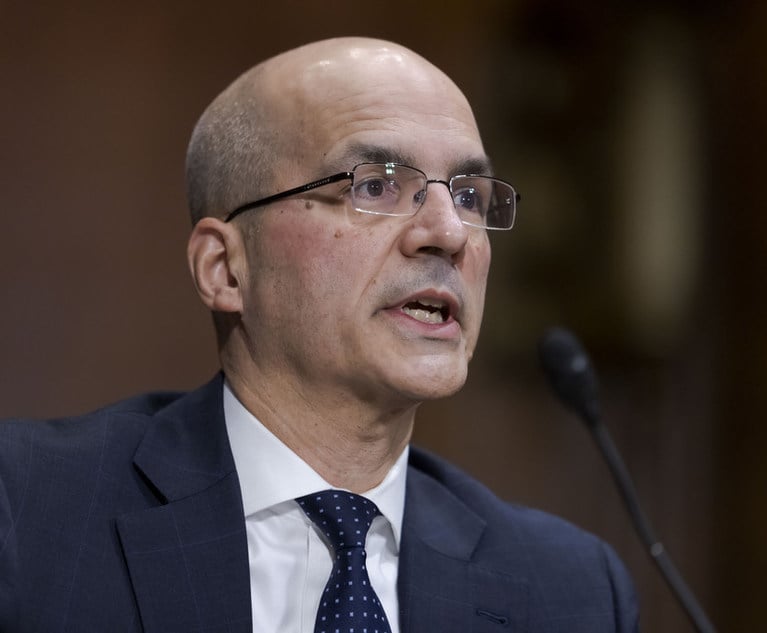The Perils of Prenups: Part III
How to effectively negotiate and draft an agreement.
March 12, 2020 at 11:45 AM
8 minute read
 Having established in Part I and Part II the dangers that prenuptial agreements create and that certain situations nevertheless require them, it may be useful to consider how to effectively negotiate and draft a prenuptial agreement in a way that minimizes the dangers and maximizes its benefits.
Having established in Part I and Part II the dangers that prenuptial agreements create and that certain situations nevertheless require them, it may be useful to consider how to effectively negotiate and draft a prenuptial agreement in a way that minimizes the dangers and maximizes its benefits.
Use the prenup as a marriage-planning document. Instead of approaching the prenup as a divorce-contingency document, view and draft it as marriage-planning one. A marriage-planning document should require the parties to consider how they intend to lead their joint lives. What can each expect from the other? How will they pay their joint and separate living expenses? If their incomes differ substantially, how will they allocate their common expenses and vacations? Will they share all of their finances, or will they each maintain some portion for discretionary, whimsical expenditures that will not be subject to the veto or judgment of the other? Though some or all of these "lifestyle" provisions may not be legally enforceable, the change of focus converts the tone of the discussions, and the resulting document helps the parties avoid surprises. A good adage in life is that any time one person is surprised, another has failed to communicate properly. Steinberger, Make More Money by Being More Ethical, 33 Family Advocate 2 at 13 (Fall 2010) (any time a client is surprised, their lawyer has failed to communicate the possible and likely outcomes). Negotiating and drafting the prenuptial agreement can be converted into an opportunity for the parties to articulate and discuss their shared values, goals and desires, memorialize their common aspirations, and set the joint vision for their union, creating a stronger basis for their marriage instead of weakening it.
Use 'fairness' as the touchstone of negotiations. To the extent that the parties can anchor their positions and negotiating style to an expectation of fairness, they can use controversy to bring them closer to one another instead of driving them further apart (applying the principle that one should view every adversity as an opportunity for improvement, and each controversy as an opportunity to forge a stronger relationship. Steinberger, supra, at 14). Use the negotiation strategies of Roger Fisher and William Ury in "Getting to Yes: Negotiating Agreement Without Giving In" by using "principled negotiation" rather than positional bargaining. Consider:
- Whether the non-monied spouse is sacrificing anything now (like giving up a home or furniture to move into the other's apartment) or during the marriage (forsaking a career or education) that could potentially leave the spouse disadvantaged at the conclusion of the marriage, and the methods that are available to fairly provide for it?
- Whether either party is contributing separate property to the acquisition of a marital-property asset (like a new home) and how that should be treated?
- How each party will be provided for at the time of their retirement?
- How the parties wish to treat any pre-marital or separate-property debt, any prior marriage's assets (like support payments from a previous spouse) or liabilities?
- How the parties can fairly treat a business interest which might become the parties' most valuable asset?
- Will one spouse be working in the other's separately-titled business and how will those efforts be fairly recognized and compensated; will it result in any ownership or other interest in the business' appreciation?
Sometimes, however, one of the betrothed is compelled by external forces to insist on certain terms that are not fair. Asking for fairness in such a situation may call attention to the otherwise invisible elephant in the room and some lawyers might object to such an approach.
Include provisions that assure the non-monied spouse's financial safety. In certain circumstances, it might be appropriate for a monied spouse to provide the non-monied spouse an annual stipend during the marriage. This money should go into a separate-property account in the non-monied spouse's name alone, and is not to be used for marital expenses. In the event of a divorce, the non-monied spouse will then have their own post-marriage security. With an amount properly set, it maximizes the enforceability of the prenup, precludes challenge to it, and is an immediate demonstration of the monied spouse's love and commitment to the betrothed.
An important cautionary note should be included here. Clients must be advised of the need to live up to this type of a prenuptial obligation all throughout the marriage. Complied with, each year's acceptance of the stipend becomes a ratification of the prenuptial agreement, strengthens it, and renders it impervious. If, however, the monied spouse fails to live up to the prenup's obligation, the breach itself makes the prenup vulnerable even if no grounds for challenge otherwise existed. As with so many other things, such a provision is a double-edged sword and clients should be cautioned to adhere to it scrupulously.
Consider and provide survivorship benefits. Particularly in second marriages where a non-monied spouse will live in the monied-spouse's home, the monied spouse should include appropriate provisions if the non-monied spouse outlives him. If the non-monied spouse waives the statutory right of election and the marital home is left to other beneficiaries, the non-monied spouse can be ejected from the home almost immediately upon the monied-spouse's death. The monied-spouse might, therefore, want to leave a life-estate to the surviving spouse or make some other direction or provision in a prenup and will for the surviving-spouse's residence, support and lifestyle.
Determine a fair methodology for apportioning the marital-appreciation of the business in a manner that will not be unduly disruptive or invasive to its operation, and will fairly recognize the non-titled spouse's contributions. The common approach of designating the pre-marital business and all its appreciation as the separate property of the titled spouse, leaves both spouses knowing that the marriage is not a total partnership. The more time, effort, and energy devoted to the business and the more the business overshadows the other marital assets or the marriage itself, the more excluded the non-titled spouse is from the marital partnership. Thus, there's great value to the parties to develop ahead of time, a fair methodology and formula that assures the non-titled spouse that they too have an interest in the success of the business. To accomplish the goals of the prenup, however, the methodology should be reasonable, predictable, and not susceptible to manipulation when the marriage unravels.
Business partnership or buy-sell agreements often contain clauses setting out the values of each partnership interest or the method to determine it in the event of the businesses' dissolution or an irreparable rift between the partners. These clauses, negotiated at arms-length, are presumptively fair to all of the business partners and necessarily delineate a spouse's value in the business. A business might also purchase "key man" life-insurance policies that provide funds for the buyout of a survivor's widow(er), revealing the expectation of that partner's interest. A prenuptial agreement can, therefore, link to those values at the time of the marriage and its dissolution, and use an appropriate formula to determine the non-titled spouse's interest in the marital-appreciation of the business. The titled spouse can then hopefully obtain financing to "cash out" the non-titled spouse's interest with little disruption to the business itself.
Audited financial statements can also be linked to with relative ease to designate a non-titled spouse's buyout from a business. When statements are routinely audited, the non-titled spouse can safely rely on their accuracy and year-to-year stability.
Alternatively, parties to a prenup can designate a trusted auditor or business valuator who will be used at the time of dissolution to determine its marital-appreciation. By agreeing in advance, the parties can avoid any later dispute over the valuator, and the disruptiveness and intrusion of unconsented-to outside evaluators.
Obviously, these are all complicated issues that must be carefully considered and developed to minimize disruption to the business but ensure fairness to both parties, so that they are both invested in the success of the marriage and its business enterprises. They also have profound psycho-social ramifications on the parties' psyches and therefore must be handled with wisdom, insight and aforethought.
All prenuptial agreements require parties to consider and plan for their worst ultimate fates–mortality or divorce. These issues should not be undertaken or treated lightly and parties undertaking it should enlist the help of not only competent lawyers but also wise legal counselors to guide them safely through these perilous shoals.
Chaim Steinberger chairs the Custody Committee of the ABA Family Law Section and is a family law attorney, litigator and mediator in New York City, NY. He is the author of "Divorce Without Destruction," "Make More Money by Being More Ethical," and "Father? What Father? Parental Alienation and its Effects on Children." He can be reached through his website, www.theNewYorkDivorceLawyers.com or by telephone, 212-964-6100.
This content has been archived. It is available through our partners, LexisNexis® and Bloomberg Law.
To view this content, please continue to their sites.
Not a Lexis Subscriber?
Subscribe Now
Not a Bloomberg Law Subscriber?
Subscribe Now
NOT FOR REPRINT
© 2025 ALM Global, LLC, All Rights Reserved. Request academic re-use from www.copyright.com. All other uses, submit a request to [email protected]. For more information visit Asset & Logo Licensing.
You Might Like
View All
'A Shock to the System’: Some Government Attorneys Are Forced Out, While Others Weigh Job Options
7 minute read
'Serious Legal Errors'?: Rival League May Appeal Following Dismissal of Soccer Antitrust Case
6 minute read
How Some Elite Law Firms Are Growing Equity Partner Ranks Faster Than Others
4 minute read
Trending Stories
- 1Donald Trump Serves Only De Facto and Not De Jure: A Status That Voids His Acts Usurping the Power of Congress or the Courts
- 2Georgia Hacker Pleads Guilty in SEC X Account Scam That Moved Markets
- 3Trump's Pick for SEC Chair Likely to Stymie Shareholder Proposals from ESG Advocates
- 4Adobe’s Chief Cyber Legal & Privacy Officer Talks Managing Gen AI Risks, Cyber Training
- 5The M&A Partners Who Drove the Most Business as Deal Leads Last Year
Who Got The Work
J. Brugh Lower of Gibbons has entered an appearance for industrial equipment supplier Devco Corporation in a pending trademark infringement lawsuit. The suit, accusing the defendant of selling knock-off Graco products, was filed Dec. 18 in New Jersey District Court by Rivkin Radler on behalf of Graco Inc. and Graco Minnesota. The case, assigned to U.S. District Judge Zahid N. Quraishi, is 3:24-cv-11294, Graco Inc. et al v. Devco Corporation.
Who Got The Work
Rebecca Maller-Stein and Kent A. Yalowitz of Arnold & Porter Kaye Scholer have entered their appearances for Hanaco Venture Capital and its executives, Lior Prosor and David Frankel, in a pending securities lawsuit. The action, filed on Dec. 24 in New York Southern District Court by Zell, Aron & Co. on behalf of Goldeneye Advisors, accuses the defendants of negligently and fraudulently managing the plaintiff's $1 million investment. The case, assigned to U.S. District Judge Vernon S. Broderick, is 1:24-cv-09918, Goldeneye Advisors, LLC v. Hanaco Venture Capital, Ltd. et al.
Who Got The Work
Attorneys from A&O Shearman has stepped in as defense counsel for Toronto-Dominion Bank and other defendants in a pending securities class action. The suit, filed Dec. 11 in New York Southern District Court by Bleichmar Fonti & Auld, accuses the defendants of concealing the bank's 'pervasive' deficiencies in regards to its compliance with the Bank Secrecy Act and the quality of its anti-money laundering controls. The case, assigned to U.S. District Judge Arun Subramanian, is 1:24-cv-09445, Gonzalez v. The Toronto-Dominion Bank et al.
Who Got The Work
Crown Castle International, a Pennsylvania company providing shared communications infrastructure, has turned to Luke D. Wolf of Gordon Rees Scully Mansukhani to fend off a pending breach-of-contract lawsuit. The court action, filed Nov. 25 in Michigan Eastern District Court by Hooper Hathaway PC on behalf of The Town Residences LLC, accuses Crown Castle of failing to transfer approximately $30,000 in utility payments from T-Mobile in breach of a roof-top lease and assignment agreement. The case, assigned to U.S. District Judge Susan K. Declercq, is 2:24-cv-13131, The Town Residences LLC v. T-Mobile US, Inc. et al.
Who Got The Work
Wilfred P. Coronato and Daniel M. Schwartz of McCarter & English have stepped in as defense counsel to Electrolux Home Products Inc. in a pending product liability lawsuit. The court action, filed Nov. 26 in New York Eastern District Court by Poulos Lopiccolo PC and Nagel Rice LLP on behalf of David Stern, alleges that the defendant's refrigerators’ drawers and shelving repeatedly break and fall apart within months after purchase. The case, assigned to U.S. District Judge Joan M. Azrack, is 2:24-cv-08204, Stern v. Electrolux Home Products, Inc.
Featured Firms
Law Offices of Gary Martin Hays & Associates, P.C.
(470) 294-1674
Law Offices of Mark E. Salomone
(857) 444-6468
Smith & Hassler
(713) 739-1250






